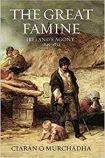The Great Famine: Ireland's Agony 1845-1852 by Ciaran O Murchadha
| The Great Famine: Ireland's Agony 1845-1852 by Ciaran O Murchadha | |
|
| |
| Category: History | |
| Reviewer: John Van der Kiste | |
| Summary: A full, vividly detailed account of the greatest humanitarian disaster of 19th century Europe, by an author who has researched the subject for over twenty years. | |
| Buy? Yes | Borrow? Yes |
| Pages: 280 | Date: June 2011 |
| Publisher: Hambledon Continuum | |
| ISBN: 978-1847252173 | |
|
| |
In August 1845, reports began to circulate of the destruction of growing potatoes in the south of England, killed by a mysterious and so far unknown plant disease. As yet, the scientific aspects of what was given the name of 'blight' were not fully recognised, let alone understood. At the end of the month, small instances of failure in the potato crop in Ireland were reported, but there seemed to be no cause for alarm until the main crop was dug out in October. Only then did it become apparent that an 'awful plague' had appeared in several areas, with decomposing vegetables producing a strong, foul stench that assailed the nostrils of cultivators and passers-by alike.
By March 1846, the first deaths from starvation were recorded. That year the situation was exacerbated by an even worse harvest in summer, affecting an estimated nearly 90% of all growing (or supposedly growing) potatoes throughout Ireland. People who had relied on the vegetable as their staple diet were left seated on the fences of their decaying gardens, wringing their hands and wailing bitterly [of] the destruction that had left them foodless. Sudden physical debilitation became commonplace, as did the incidence of diseases such as dysentery and dropsy. To these were later added an epidemic of cholera, which took its toll of many of the physically weakened and starving, and led parents or siblings to shrink in revulsion from stricken family members. In desperation the poor killed their horses, donkeys and domestic pets for food, while rabbits, hares, foxes and badgers were trapped for a similar purpose. Robberies of grain and other foodstuffs multiplied, as did other petty larcenies and crimes by those who were desperate to be sent to prison, safe in the knowledge that once incarcerated they would at least be adequately fed.
Another bad harvest in the summer of 1848 was exacerbated by exceptionally heavy rain, and during one fortnight in August there were only two days without rain reported. In what might be seen as a startlingly insensitive move the British government chose to send Queen Victoria and Prince Albert on a royal visit to Ireland. Their reception was loyal enough, especially given the circumstances, but although it was kept fairly low-key without too much ostentation, the overall cost of about £2,000 was almost exactly the amount of the Queen's personal donation to Irish famine relief.
Thousands were sent to the workhouse, where ragged crowds would come to settle, and many more died as they lay outside the walls, having come to seek admission but were too close to physical exhaustion to survive. Landlords would take advantage of their absences to reclaim or even destroy their houses, employing wreckers who had been plied more adequately with whisky before being brought to do their job. In 1847 Major Dennis Mahon, one of those most responsible for 'famine clearances' in evicting 3,000 tenants, and sending wreckers to destroy temporary huts erected by evicted tenants, was shot dead. The event was celebrated by the lighting of bonfires lit on surrounding hills by many of the surviving tenants, glad that he had had what they considered his just deserts.
The resulting emigrations, led by those looking for a better life, usually in America, Canada or Britain, represented one of the greatest population displacements of modern times. Some 2.1 million, or around a quarter, left their homeland. Among those who are thought to have 'famine emigrant ancestry' are the Kennedys, Henry Ford, Muhammad Ali and Barack Obama. Many of them could not speak English, were overwhelmed by their unfamiliar new surroundings, and soon became the victims of racial hostility. Only a few lucky ones were able to raise themselves much above the condition in which they arrived. 'The Times' painted a stark picture of an England positively invaded, overrun, devoured, infected, poisoned and desolated by Irish pauperdom. While the famine was in effect over by 1852, the reverberations on Irish society and on Anglo-Irish relations would reverberate for more than a generation.
Murchadha paints a vivid portrait in words of the grim few years, supplemented by some equally harrowing pictures integrated with the text. Academic research into the subject is a comparatively recent phenomenon, and he has produced plenty of individual stories of incidents that took place during that unhappy age. He concludes by suggesting that if genocide can be taken to signify the deliberate, systematic use of an environmental catastrophe to destroy a people under the pretext of engineering social reform, there is certainly a case to be answered. Anybody wanting to understand some of the historical underlying resentment of the smaller nation towards the larger over the last two centuries could hardly do better than to start with this book.
Our thanks to Hambledon Continuum for sending a review copy to Bookbag.
If you enjoyed this, for another, albeit lighter read on Ireland from a more modern perspective, you might enjoy Memories of the Rare Old Times: Through The Eyes of a Dubliner by Bernard P Morgan.
Please share on: ![]() Facebook,
Facebook, ![]() Twitter and
Twitter and
![]() Instagram
Instagram
![]() You can read more book reviews or buy The Great Famine: Ireland's Agony 1845-1852 by Ciaran O Murchadha at Amazon.co.uk Amazon currently charges £2.99 for standard delivery for orders under £20, over which delivery is free.
You can read more book reviews or buy The Great Famine: Ireland's Agony 1845-1852 by Ciaran O Murchadha at Amazon.co.uk Amazon currently charges £2.99 for standard delivery for orders under £20, over which delivery is free.
![]() You can read more book reviews or buy The Great Famine: Ireland's Agony 1845-1852 by Ciaran O Murchadha at Amazon.com.
You can read more book reviews or buy The Great Famine: Ireland's Agony 1845-1852 by Ciaran O Murchadha at Amazon.com.
Comments
Like to comment on this review?
Just send us an email and we'll put the best up on the site.


